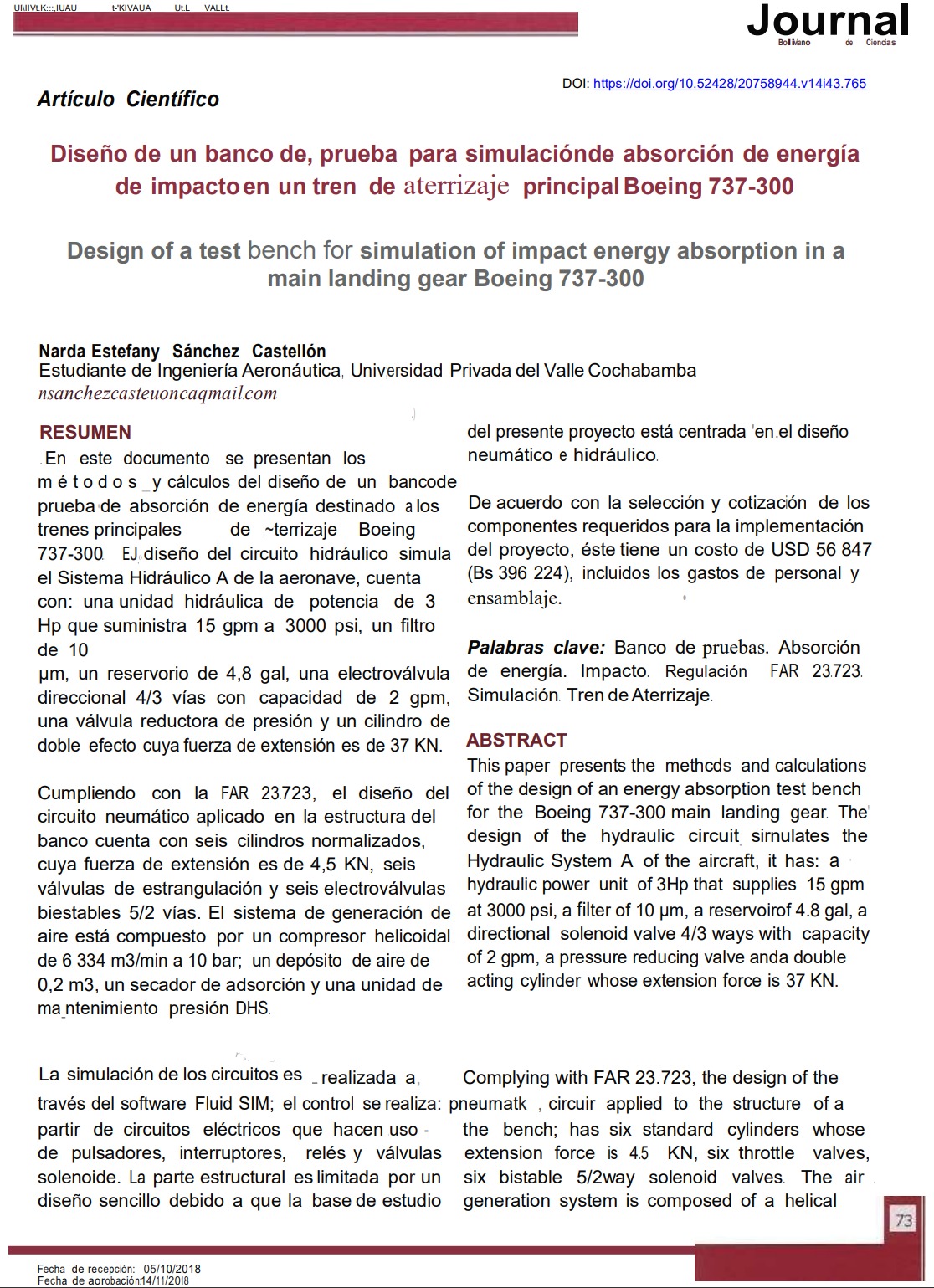Design of a Test Bench for Simulation of Impact Energy Absorption in a Main Landing Gear Boeing 737-300
DOI:
https://doi.org/10.52428/20758944.v14i43.765Keywords:
Testing Bench, Energy Absorption, lmpact, Regulation FAR 23.723, Simulation, Landing GearAbstract
This paper presents the methcds and calculations of the design of an energy absorption test bench for the Boeing 737-300 main landing gear. The' design of the hydraulic circuit sirnulates the Hydraulic System A of the aircraft, it has: a · hydraulic power unit of 3Hp that supplies 15 gpm at 3000 psi, a filter of 10 pm, a reservoirof 4.8 gal, a directional solenoid valve 4/3 ways with capacity of 2 gpm, a pressure reducing valve anda double acting cylinder whose extension force is 37 KN. Complying with FAR 23.723, the design of the pneumatic , circuir applied to the structure of a the bench; has six standard cylinders whose extension force is 4.5 KN, six throttle valves, six bistable 5/2way solenoid valves. The air generation system is composed of a helical compressor from 6.334 m3/min to 10 bar; an air tank of 0.2 m3, an adsorption dryer and a DHS pressure maintenance unit. The simulation of the circuits is done through the FluidSIM® software; the control is made from electrical circuits that use push buttons, switches, relays, and solenoid valves. The structural part is limited by a simple design because the base of study of the present project is centered on the pneumatic and hydraulic design. According to the selection and quotation of the components required for the implementation of the project, it has a cost of USD56,847 (Bs396,224), including staff and assembly costs.
Downloads
References
l) Boeing Company. (1984). Training Manual 8737-300/400/500 ATA 32 Landing Gear (2da Ed.). Chicago, Estados Unidos: Boeing Company.
Creus Solé, A. (2007). Neumática e hidráulica (lera Ed.). Barcelona: Marcombo.
Currey, N. (2007). Aircraft landing gear design (2da Ed.). Norwich, New York: Knovel.
Esteban Oñate,A. (2007). Conocimientos del avión (2da Ed.). Madrid: Thomson-Paraninfo.
Federal Aviation Administration, FAA. (1997). Federal Aviation Regulation (FAR) Part 23 Landing Gear (lera ed.). Washington D.C: Federal Aviation Administration (FAA).
Gómez Rodríguez, J. (2013). Tren de aterrizaje del FOCKE WULF FW 190, reconstrucción y análisis virtual (lera ed.). Barcelona: Universidad Politécnica de Cataluña.
Heckmann, H., Heckmann, R. y Heckmann, C. (2Dl 7). Mecánica-Dinámica (lera Ed.). Hamburg,Alemania: Gunt Hamburg. p.144-145.
Hertzberg, R., Vinci, R. y Hertzberg, J. (2012). Deformation and fracture mechanics of engineering materials (Sta Ed.). Hoboken, NJ: John Wiley & Sons, lnc.
Langewiesc he, W. (1994). Stick & rudder (2da Ed.). New York: McGraw-Hill.
Michelín AircraftTire. (2001). AircraftTire Engineering Data (lera Ed.). Greenville, South Carolina: Michelín.
Serway, R. y Jewett, J. (2004). Physics for scientists and engineers (6ta Ed.). Belmont, CA: Thomson-Brooks/Cole.
Sterkenburg, D., Rahm, M., Eismain, D., McNeill, M., Forenz, M. y Wang, M. (2013). Handbooks Manuals - Chapter 13: Aircraft Landing Gear Systems (lera Ed.). Washington D.C.: Federal Aviation Administration. p. l-96.
Torenbeek, E. (1982). Synthesis of Subsonic Airplane Design (lera Ed.). The Netherlands: Delft University Press. https://doi.org/10.1007/978-94-017-3202-4

Downloads
Published
How to Cite
Issue
Section
License
Copyright (c) 2018 Narda Estefany Sánchez Castellón

This work is licensed under a Creative Commons Attribution 4.0 International License.
Authors who publish with this journal agree to the following terms:
- Authors retain copyright and grant the journal right of first publication with the work simultaneously licensed under a Creative Commons Attribution License 4.0 that allows others to share the work with an acknowledgement of the work's authorship and initial publication in this journal.
- Authors are able to enter into separate, additional contractual arrangements for the non-exclusive distribution of the journal's published version of the work (e.g., post it to an institutional repository or publish it in a book), with an acknowledgement of its initial publication in this journal.
- Authors are permitted and encouraged to post their work online (e.g., in institutional repositories or on their website) prior to and during the submission process, as it can lead to productive exchanges, as well as earlier and greater citation of published work.














